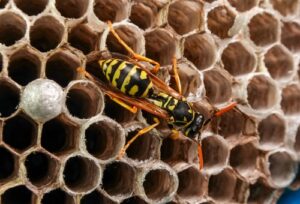Home / Blog / Bees / The Buzz on Bees: Do Bumble Bees Sting and What to Do If They Do
The Buzz on Bees: Do Bumble Bees Sting and What to Do If They Do

Scientifically reviewed by Rachel Maldonado
-Published on April 5, 2024
-Updated on July 31, 2024
The Buzz on Bees: Do Bumble Bees Sting and What to Do If They Do
During the warm spring and summer months, there’s nothing that’s quite as lovely as hearing the harmonic hum of bumblebees fill the air. As these creatures flit from bloom to bloom, you might be wondering if bumblebees pose any real threat. Do bumblebees sting – and what should you do if you’re stung?
We all know the many benefits bumblebees provide to the environment, helping to pollinate plants and keep ecosystems healthy. But when push comes to shove, they can occasionally deliver a nasty sting.
Here’s what you need to know.
Understanding Bumble Bees

Bumble bees are plump, fuzzy creatures that are plants’ best friends. Their large bodies make them excellent pollinators, transferring pollen between flowers as they feed on nectar.
These social insects live in colonies, usually underground in old rodent burrows or other nooks they can convert into a home.
The bumble bee colony is a complex society of workers and a queen, each with their own role to play in the grand scheme.
Unlike their more aggressive cousins, such as yellow jackets and hornets, bumble bees are relatively docile. They are furrier and more robust, which allows them to withstand cooler temperatures and keeps them from foraging for as long periods as honeybees.
The bumble bee colony revolves around the queen, who is the mother of all the bees in the nest. She begins the year by rearing a group of workers, who then take over the duties of foraging and caring for the next generation. The end of the season sees new queens emerge, mate, and hibernate until they can repeat the cycle.
Do Bumble Bees Sting?
When it comes to the risk of a sting, the most important factor to consider is whether the bee is foraging – or protecting its nest.
Foraging bumble bees are generally not looking for a fight. They’re too busy gathering nectar and pollen to bother with humans. Stings while a bee is foraging are rare, but not impossible, especially if a bee is accidentally touched or feels threatened.
However, there’s an increased likelihood of a sting if the nest is disturbed. As such, it’s best to give a bumble bee’s nest a wide berth. If you disturb their home, particularly if the entrance is blocked or they feel cornered, bumble bee workers will ultimately defend their colony. This can result in multiple stings from a swarm of aggravated bees.
Comparison with Honey Bees and Other Bee Species
The classic honey bee, renowned for its ability to produce honey, is another close relative whose stinging behaviors are important to understand.
The first difference is in the stinger. Honey bees have a barbed stinger that is designed to deeply penetrate predators or other threats. This barb is one-way, which means their stinger remains in the victim, killing the bee in the process. Bumble bees, however, do not have this and can sting multiple times because of their smooth stinger.
Carpenter bees are often mistaken for bumble bees due to their similar appearance, but they live alone rather than in a colony. This solitary lifestyle means they pose little threat, as they are not territorial or defensive of a communal living space.
Dealing with Bumble Bees
Living harmoniously alongside bumble bees doesn’t have to be a challenge.
Here are some tips to help you stay safe:
- Don’t swat or squash them: This may seem like common sense, but acting calmly and predictably around bumble bees goes a long way in preventing unexpected stings.
- Be mindful of their nest locations: Before mowing lawns or disturbing bushes, take a few moments to observe bee activity. If a nest is suspected, avoid the area or use the knowledge to approach it gently.
- Protective clothing: If you’re planning to be near a nest, wearing a hat and long sleeves can provide an extra layer of defense.
What to Do if You’re Stung by a Bumble Bee
So what should you do if you come into contact with a bumble bee?
First, stay calm. Although a bumble bee sting is painful, for most people, it’s not dangerous. Staying calm helps to keep your heart rate down and slows the spread of venom through your system.
Over-the-counter remedies like antihistamines and gels can alleviate the pain and swelling. For a home remedy, a paste of baking soda and water can also provide relief. If you have a severe allergic reaction, seek medical attention immediately.
Key Takeaways
So the next time you happen to hear the buzz of a bumble bee, you can rest assured that you now have the understanding you need to navigate around them safely – and to give these hardworking insects the respect they deserve.
While they may certainly pack a sting, the benefits of honeybees to the garden can’t be overlooked. In most cases, they far outweigh the risk of a sting – so leave them alone and let them do their work.
If you’re not sure what kind of bee you’re dealing with, it’s wise to give Hawx Pest control a call. We’ll make sure your property is free from stinging insects (at least, the ones who are most likely to give you problems!) and we’ll employ the latest techniques and products to make sure this is done in the most eco-friendly way possible.
Join Hawx Pest Control’s family of satisfied customers – and “bee safe” next time you’re out and about in your garden.
Related Articles
Visit our blog to learn more.
→







